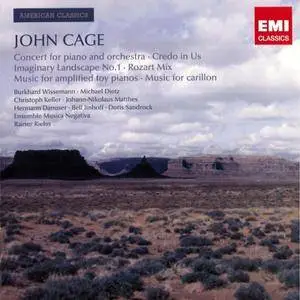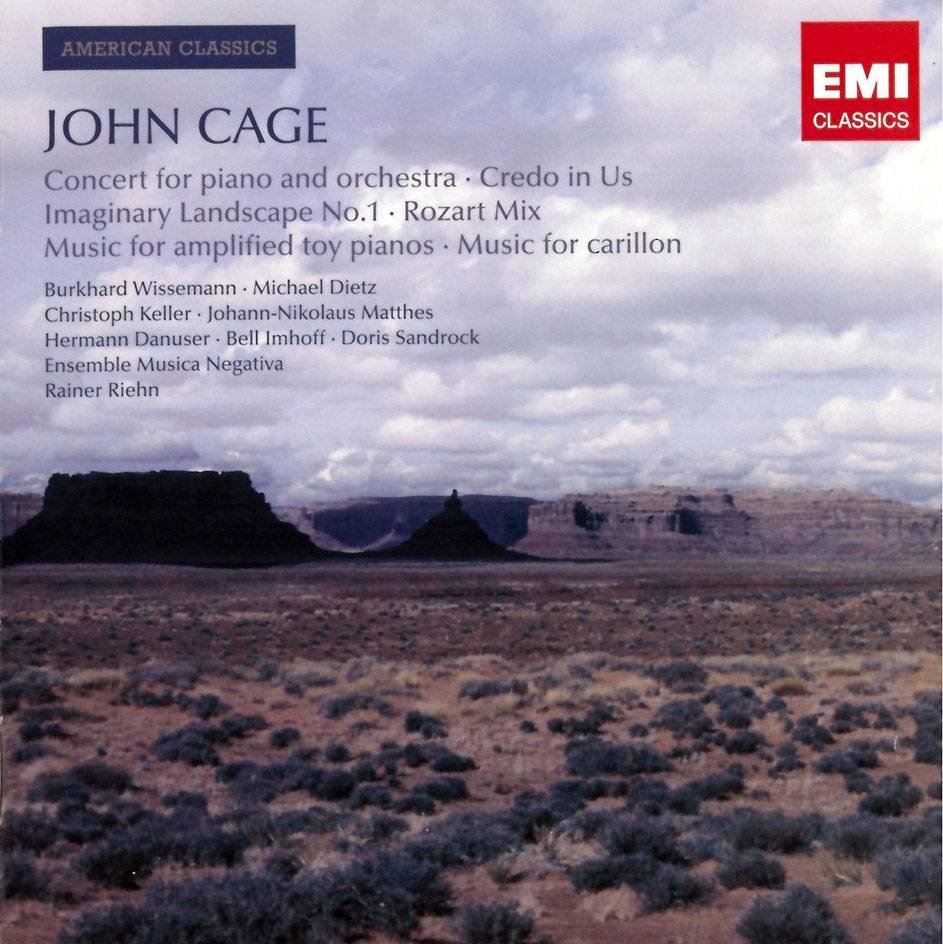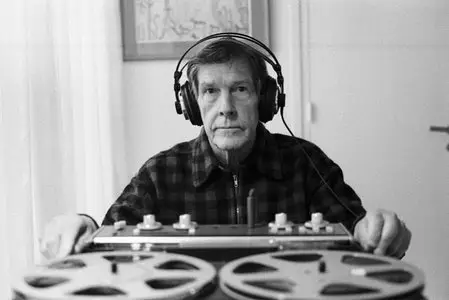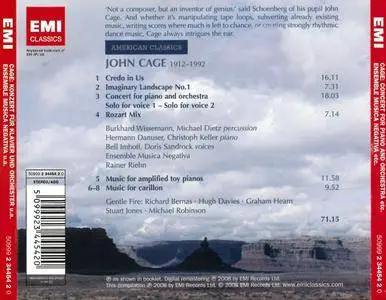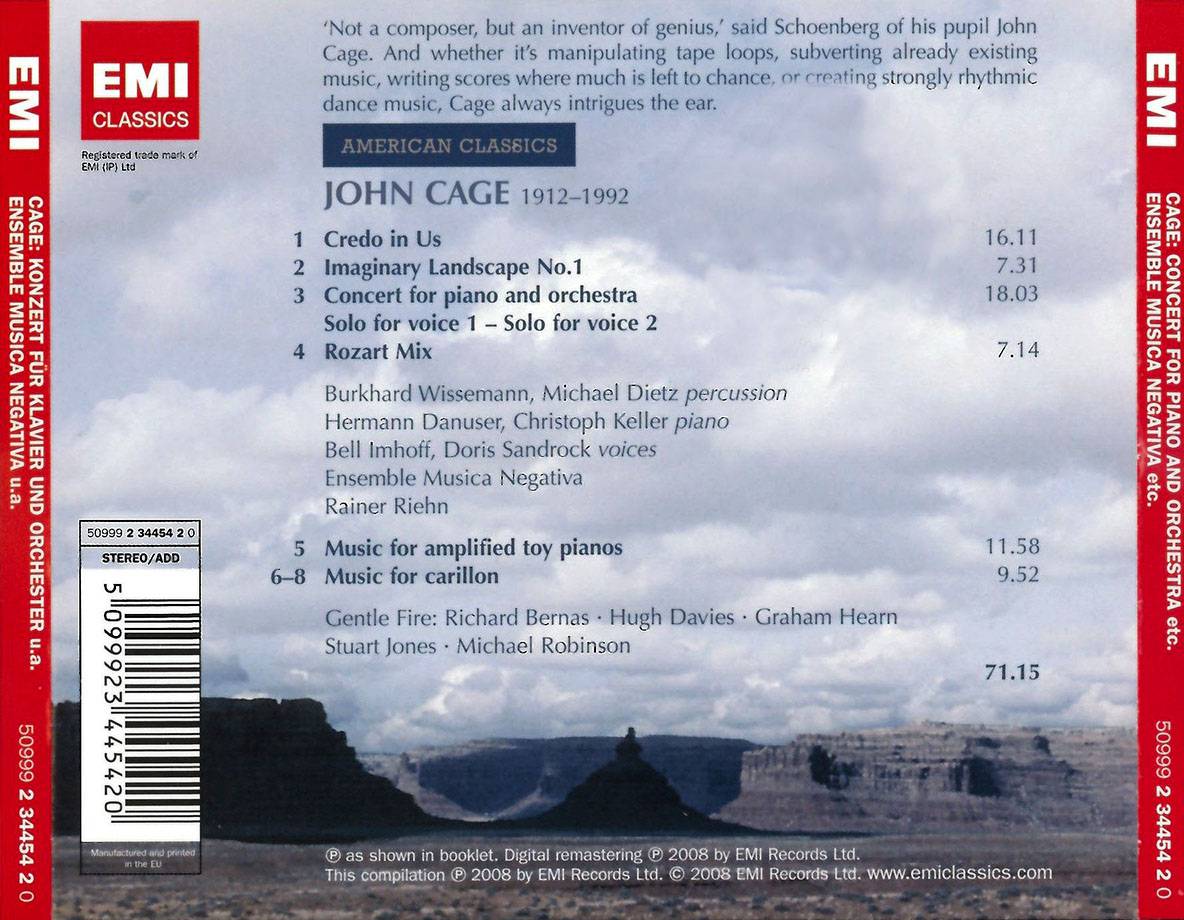John Cage: Piano Concerto; Credo in Us; Imaginary Landscape No.1; Rozart Mix; Music for Carillon (2008)
Burkhard Wissemann, Michael Dietz; Johann-Nikolaus Matthes; Bell Imhoff, Doris Sandrock
Christoph Keller; Hermann Danuser, Ensemble Musica Negativa, Rainer Riehn
EAC | FLAC | Image (Cue&Log) ~ 352 Mb | Mp3 (CBR320) ~ 166 Mb | Scans included
Classical, Avant-Garde, Electronic | Label: EMI | # 50999 2 34454 2 0 | Time: 01:11:15
Burkhard Wissemann, Michael Dietz; Johann-Nikolaus Matthes; Bell Imhoff, Doris Sandrock
Christoph Keller; Hermann Danuser, Ensemble Musica Negativa, Rainer Riehn
EAC | FLAC | Image (Cue&Log) ~ 352 Mb | Mp3 (CBR320) ~ 166 Mb | Scans included
Classical, Avant-Garde, Electronic | Label: EMI | # 50999 2 34454 2 0 | Time: 01:11:15
John Cage (1912-1992) was one of the most controversial composers of the 20th century. He is best known for his 1952 work 4'33" which involves not a single note of music being played. This selection of Cage's music provides a rare opportunity to get to know a range of works that were written between the years 1939-65, which were some of the composer's most productive years. Credo in Us is a ballet score written for Cage's long-time partner and collaborator the choreographer and dancer, Merce Cunningham. Imaginary Landscape is scored for four performers who play a muted piano and cymbal as well as two variable-speed phonographs with amplifiers, Imaginary Landscape No.1 is important for being one of the first examples of electro-acoustic music. Cage's Concert for Piano and Orchestra has no overall score, but all the parts are written out in detail. A performance of the Concert may include all of the instruments, but may also be performed as a solo, duet, trio or any combination of the given instruments, resulting in a change of title (e.g. solo for piano or Concert for piano, voice and 2 violins, in case it is combined with a Solo for Voice.) In this recording two solo voices are used. The Suite for Toy Piano is one of Cage's works for prepared piano and the Music for Carillon bring this collection to a fascinating conclusion.
This is a spectacularly well-planned disc, revealing various facets of the enigma/inventor - the latter Schoenberg’s term - that was John Cage. We hear works whose sounded surface is generated by indeterminacy, chaotic juxtapositions and a catalogue of gorgeous sounds. These include some gorgeous silences created by the music that surrounds them. Although recording dates are 1971 and 1973, the transfers are immaculate - played blind, I would defy anyone to place them in that era such is the clarity on offer. The recorded order works perfectly for straight play-through.
The first of many disorientating things on this disc is the opening of Credo in US - which actually starts with the beginning of the finale of Dvořák’s “New World” Symphony in an uncredited performance which zooms in and out of focus while effectively determining the progress of the Cage piece - as the Dvořák ends, so does the Cage. The 1971 recording is astonishing in its presence and its stereo separation and effects. Credo in US was the earliest piece Cage wrote for his partner in the mid-1940s, the choreographer Merce Cunningham. Dvořák’s music intertwines with, is subverted by and complements Cage’s in the most spellbinding way. Snippets from radio plays are juxtaposed with block piano chords; jazz suddenly appears - just after twelve minutes - pure and unannounced. The performance and recording are beyond reproach. There are other performances available (Col Legno and Wergo) and they will complement this one perfectly. But at the price point, this is unbeatable.
The Imaginary Landscape No. 1 dates from only three years earlier and is scored for pre-recorded sounds again, but this time from frequency test discs played on variable-speed turntables. I agree entirely with the booklet note annotator, Martin Cotton, that the “unearthly swooping and repetitive phrases, over a stately rhythmic pulse, give the piece a strangely processional, ritualistic character” . Spot-on. The actual sounds are often like - for those old enough to remember - “The Clangers” , just with a little more timbral body.
Cage enjoyed experimenting with indeterminacy in the 1950s, and on top of that he also enjoyed allowing the performance of some of his pieces literally on top of others. Both are involved in this recording of the scoreless Concert for Piano and Orchestra. There are parts, but no score. Soloist and each instrumentalist all have parts, randomly generated by chance processes, and the pages can be delivered in any order. Here the Concert is juxtaposed with the two Solos for voice (also chance pieces). The result is truly spellbinding in its randomness. Remember, randomness itself poses an interpretative dilemma to the performers and asks them to react to their peers in real time. It is here that the musicianship of the performers is drawn on, and this performance is as compelling as any you are likely to encounter. The voice pieces are superbly “sung” by Bell Imhoff and Doris Sandrock; they really do take on a shape, too, with climaxes and plateaux.
Rozart Mix takes longer to explain than it does to listen to - at least in this performance. The “score” is actually correspondence between Cage and Alvin Lucier for the preparation of the first performance. It is scored for “at least four performers with at least 12 tape recorders and at least 88 tape-loops” , loops that can comprise speech and/or music. The piece, in theory, begins with the entrance of the first audience member and ends with the exit of the last. At the premiere, it was about two hours long; here, it is a mere 4½ minutes. But what a fascinating, beautiful 4½ minutes they are. The music here is slow and contemplative, the perfect chill-out - if I may use that horribly modern phrase - after the Concert.
The gorgeous sonorities of the Suite for Toy Piano make a powerful effect - but who is the performer? It is bracketed with the Music for Carillon in the booklet - hence the superscripting in the title - but is clearly not for the same instruments and has a completely different recording date. Moreover, the booklet notes make mention of the Suite before implying that the piece on the disc is actually the 1960 Music for Amplified Toy Pianos. Whoever and whatever it is, it is beautifully played, making telling use of the gaps between the notes. Timbrally, it sounds too diverse to be played just on a single toy piano, even an extensively prepared one..
Finally, Music for Carillon, a set of three pieces. The score of No. 1 consists of a sequence of rectangles with dots in them, indicating pitch on the vertical and time on the horizontal. The second piece is similarly constructed, but with Cage using cardboard with holes punched into it; the third is the same as the second, but with the cardboard turned upside down. The music is actually supremely beautiful and here the recording quality really stands out.
A sure-fire winner. Just a pity EMI could not get their documentation straight.Review by Colin Clarke, MusicWeb-International.com
By virtue of including John Cage in its American Classics series, EMI Classics demonstrates a heightened understanding of the importance of contemporary music unusual for the label, drawing from the EMI Electrola catalog in Germany. In American Classics: John Cage, two rare, LP-era recordings made in 1972-1973 are included; one extracted from a highly regarded, coveted four-LP box set Music Before Revolution by German new music group Ensemble Musica Negativa, and another couple of pieces drawn from an album by the English ensemble Gentle Fire only issued in Germany. Ensemble Musica Negativa, led by Heinz-Klaus Metzger and Rainer Riehn, perform Cage's early works Credo in Us (1942) and Imaginary Landscape No. 1 (1939); in the Credo, pianist Christoph Keller plays the piano part very well, and Johann-Nikolaus Matthes also proves quite handy at realizing Cage's whimsical turntable part; it almost comes off at points like a proto-techno piece, and it fully embraces Cage's intentions in terms of the effect of "surprise." However, the percussion playing in the piece is not particularly strong, seems hesitant, and not quite up to speed. Imaginary Landscape No. 1 is a very interesting choice, as it is seldom played owing to its requirement of two variable speed turntables equipped with a foot pedal and frequency records, this sounds more like a standard frequency tester with a dial, and perhaps that's what's in use. Taking advantage of some options that Cage did prescribe, the Concert for Piano and Orchestra – or at least, some parts from the score – are performed in tandem with the Solos for Voice 1 and 2, sung simultaneously by sopranos Bell Imhoff and Doris Sandrock. The interpretation sounds just like a typical Darmstadt Festival-styled chamber work by Boulez or Stockhausen, and that's none too surprising as Ensemble Musica Negativa's Heinz-Klaus Metzger had very strong ties with Stockhausen at the time and, up to a certain point, both he and Riehn participated in Stockhausen's performances as well. There is an extent to which certain Cage scores can tend to take on the raiment of the given environment in which they are performed, but this seems more like an interpretation that imposes its will upon Cage's materials. However, Metzger and Riehn later became artistic directors of the Frankfurt Opera and commissioned the Europeras 1 and 2 from Cage, which he happily accepted.
Truly surprising is the filler; two Cage works performed by Gentle Fire, or at least some of the members of this important British new music collective more or less headed by Hugh Davies; active from 1968 to 1975, most of the group's recordings were never released. Music for Amplified Toy Pianos (1960) has a score of transparencies similar to Cartridge Music; however, whereas Cartridge Music tends to be very noisy and busy, Music for Amplified Toy Pianos is very wispy and often silent. This performance is true to Cage's intentions and sounds more like him than the earlier material. Gentle Fire has the patience to wait out the silence as prescribed; not many performers in 1973 were quite yet to that point of involvement or patience with Cage's work. All three versions of Music for Carillon (1952) are included in a slightly hissy recording made at Loughborough Carillon in Leicestershire; while credited to the group as a whole, this performance was made by Graham Hearn alone.
The liner notes and track listing to this disc are very sloppy; Music for Amplified Toy Pianos is listed on the inside cover, front, and back as Suite for Toy Piano, a work this is certainly not. However, the most egregious problem is that the 4:31 track identified as Cage's Rozart Mix is not that at all; judging from the instrumentation in use, this appears to be The Straits of Magellan by Morton Feldman combined with perhaps a stray fragment of an Earle Brown piano piece attached to it. These are other tracks from Music Before Revolution but are not works by Cage; EMI's inattention to this detail is unfathomable and renders what was a promising product at least partly defective.Review by Uncle Dave Lewis, Allmusic.com
Performers:
Burkhard Wissemann, Michael Dietz percussion
Christoph Keller piano
Johann-Nikolaus Matthes turntables (phonograph), electronics (radio)
Christoph Keller piano
Hermann Danuser piano
Bell Imhoff, Doris Sandrock voices
Ensemble Musica Negativa
Rainer Riehn
Gentle Fire
Tracklist:
01. Credo in Us (16:11)
02. Imaginary Landscape No.1 (07:34)
03. Concert for Piano and Orchestra - Solo for Voice 1 - Solo for Voice 2 (18:05)
04. Rozart Mix (07:19)
05. Music for Amplified Toy Pianos (12:02)
06. Music for Carillon - No.1 (07:00)
07. Music for Carillon - No.2 (01:29)
08. Music for Carillon - No.3 (01:30)
Exact Audio Copy V1.0 beta 3 from 29. August 2011
EAC extraction logfile from 11. June 2015, 1:36
- / Cage - Concert for Piano and Orchestra etc.
Used drive : HL-DT-STDVDRAM GU70N Adapter: 0 ID: 0
Read mode : Secure
Utilize accurate stream : Yes
Defeat audio cache : Yes
Make use of C2 pointers : No
Read offset correction : 48
Overread into Lead-In and Lead-Out : No
Fill up missing offset samples with silence : Yes
Delete leading and trailing silent blocks : No
Null samples used in CRC calculations : Yes
Used interface : Native Win32 interface for Win NT & 2000
Used output format : User Defined Encoder
Selected bitrate : 128 kBit/s
Quality : High
Add ID3 tag : No
Command line compressor : C:\Program Files (x86)\Exact Audio Copy\Flac\flac.exe
Additional command line options : -V -8 -T "Date=%year%" -T "Genre=%genre%" %source%
TOC of the extracted CD
Track | Start | Length | Start sector | End sector
––––––––––––––––––––––––––––-
1 | 0:00.00 | 16:11.56 | 0 | 72880
2 | 16:11.56 | 7:34.03 | 72881 | 106933
3 | 23:45.59 | 18:05.72 | 106934 | 188380
4 | 41:51.56 | 7:19.52 | 188381 | 221357
5 | 49:11.33 | 12:02.61 | 221358 | 275568
6 | 61:14.19 | 7:00.26 | 275569 | 307094
7 | 68:14.45 | 1:29.51 | 307095 | 313820
8 | 69:44.21 | 1:30.46 | 313821 | 320616
Range status and errors
Selected range
Filename C:\temp\Cage - Piano Concerto; Credo in Us; Imaginary Landscape No.1\Cage - Concert for Piano and Orchestra etc.wav
Peak level 99.9 %
Extraction speed 5.4 X
Range quality 100.0 %
Test CRC 614BD8AF
Copy CRC 614BD8AF
Copy OK
No errors occurred
AccurateRip summary
Track 1 accurately ripped (confidence 3) [61F125E1] (AR v2)
Track 2 accurately ripped (confidence 3) [ED5DFDAB] (AR v2)
Track 3 accurately ripped (confidence 3) [EEA0C0B1] (AR v2)
Track 4 accurately ripped (confidence 3) [290CB533] (AR v2)
Track 5 accurately ripped (confidence 3) [258C8370] (AR v2)
Track 6 accurately ripped (confidence 3) [8CE4EB2B] (AR v2)
Track 7 accurately ripped (confidence 3) [731ADDE1] (AR v2)
Track 8 accurately ripped (confidence 3) [765F7222] (AR v2)
All tracks accurately ripped
End of status report
==== Log checksum 7BAC08055918B761C43F2CC5C8AFC73D1AFE920887A1E39C39835C298F4B0B4D ====
EAC extraction logfile from 11. June 2015, 1:36
- / Cage - Concert for Piano and Orchestra etc.
Used drive : HL-DT-STDVDRAM GU70N Adapter: 0 ID: 0
Read mode : Secure
Utilize accurate stream : Yes
Defeat audio cache : Yes
Make use of C2 pointers : No
Read offset correction : 48
Overread into Lead-In and Lead-Out : No
Fill up missing offset samples with silence : Yes
Delete leading and trailing silent blocks : No
Null samples used in CRC calculations : Yes
Used interface : Native Win32 interface for Win NT & 2000
Used output format : User Defined Encoder
Selected bitrate : 128 kBit/s
Quality : High
Add ID3 tag : No
Command line compressor : C:\Program Files (x86)\Exact Audio Copy\Flac\flac.exe
Additional command line options : -V -8 -T "Date=%year%" -T "Genre=%genre%" %source%
TOC of the extracted CD
Track | Start | Length | Start sector | End sector
––––––––––––––––––––––––––––-
1 | 0:00.00 | 16:11.56 | 0 | 72880
2 | 16:11.56 | 7:34.03 | 72881 | 106933
3 | 23:45.59 | 18:05.72 | 106934 | 188380
4 | 41:51.56 | 7:19.52 | 188381 | 221357
5 | 49:11.33 | 12:02.61 | 221358 | 275568
6 | 61:14.19 | 7:00.26 | 275569 | 307094
7 | 68:14.45 | 1:29.51 | 307095 | 313820
8 | 69:44.21 | 1:30.46 | 313821 | 320616
Range status and errors
Selected range
Filename C:\temp\Cage - Piano Concerto; Credo in Us; Imaginary Landscape No.1\Cage - Concert for Piano and Orchestra etc.wav
Peak level 99.9 %
Extraction speed 5.4 X
Range quality 100.0 %
Test CRC 614BD8AF
Copy CRC 614BD8AF
Copy OK
No errors occurred
AccurateRip summary
Track 1 accurately ripped (confidence 3) [61F125E1] (AR v2)
Track 2 accurately ripped (confidence 3) [ED5DFDAB] (AR v2)
Track 3 accurately ripped (confidence 3) [EEA0C0B1] (AR v2)
Track 4 accurately ripped (confidence 3) [290CB533] (AR v2)
Track 5 accurately ripped (confidence 3) [258C8370] (AR v2)
Track 6 accurately ripped (confidence 3) [8CE4EB2B] (AR v2)
Track 7 accurately ripped (confidence 3) [731ADDE1] (AR v2)
Track 8 accurately ripped (confidence 3) [765F7222] (AR v2)
All tracks accurately ripped
End of status report
==== Log checksum 7BAC08055918B761C43F2CC5C8AFC73D1AFE920887A1E39C39835C298F4B0B4D ====
foobar2000 1.2 / Dynamic Range Meter 1.1.1
log date: 2016-03-01 17:14:15
––––––––––––––––––––––––––––––––––––––––
Analyzed: Burkhard Wissemann, Michael Dietz, Christoph Keller, Johann-Nikolaus Matthes, Rainer Riehn / Cage - Concert for Piano and Orchestra etc. (1)
Gentle Fire / Cage - Concert for Piano and Orchestra etc. (2-5)
––––––––––––––––––––––––––––––––––––––––
DR Peak RMS Duration Track
––––––––––––––––––––––––––––––––––––––––
DR11 -0.01 dB -16.45 dB 16:12 01-Credo in Us
DR24 -0.01 dB -31.40 dB 12:03 05-Music for Amplified Toy Pianos
DR11 -0.01 dB -16.11 dB 7:00 06-Music for Carillon - No.1
DR10 -0.01 dB -15.19 dB 1:30 07-Music for Carillon - No.2
DR11 -0.01 dB -16.31 dB 1:31 08-Music for Carillon - No.3
––––––––––––––––––––––––––––––––––––––––
Number of tracks: 5
Official DR value: DR14
Samplerate: 44100 Hz
Channels: 2
Bits per sample: 16
Bitrate: 685 kbps
Codec: FLAC
================================================================================
––––––––––––––––––––––––––––––––––––––––
Analyzed: Hermann Danuser, Bell Imhoff, Doris Sandrock, Ensemble Musica Negativa, Rainer Riehn / Cage - Concert for Piano and Orchestra etc. (1)
Members of the Ensemble Musica Negativa / Cage - Concert for Piano and Orchestra etc. (2)
––––––––––––––––––––––––––––––––––––––––
DR Peak RMS Duration Track
––––––––––––––––––––––––––––––––––––––––
DR12 -0.01 dB -17.32 dB 18:06 03-Concert for Piano and Orchestra - Solo for Voice 1 - Solo for Voice 2
DR11 -0.49 dB -14.54 dB 7:20 04-Rozart Mix
––––––––––––––––––––––––––––––––––––––––
Number of tracks: 2
Official DR value: DR11
Samplerate: 44100 Hz
Channels: 2
Bits per sample: 16
Bitrate: 685 kbps
Codec: FLAC
================================================================================
––––––––––––––––––––––––––––––––––––––––
Statistics for: 02-Imaginary Landscape No.1
Number of samples: 20023164
Duration: 7:34
––––––––––––––––––––––––––––––––––––––––
Left Right
Peak Value: -0.01 dB –- -2.64 dB
Avg RMS: -12.06 dB –- -12.78 dB
DR channel: 9.36 dB –- 6.97 dB
––––––––––––––––––––––––––––––––––––––––
Official DR Value: DR8
Samplerate: 44100 Hz
Channels: 2
Bits per sample: 16
Bitrate: 685 kbps
Codec: FLAC
================================================================================
log date: 2016-03-01 17:14:15
––––––––––––––––––––––––––––––––––––––––
Analyzed: Burkhard Wissemann, Michael Dietz, Christoph Keller, Johann-Nikolaus Matthes, Rainer Riehn / Cage - Concert for Piano and Orchestra etc. (1)
Gentle Fire / Cage - Concert for Piano and Orchestra etc. (2-5)
––––––––––––––––––––––––––––––––––––––––
DR Peak RMS Duration Track
––––––––––––––––––––––––––––––––––––––––
DR11 -0.01 dB -16.45 dB 16:12 01-Credo in Us
DR24 -0.01 dB -31.40 dB 12:03 05-Music for Amplified Toy Pianos
DR11 -0.01 dB -16.11 dB 7:00 06-Music for Carillon - No.1
DR10 -0.01 dB -15.19 dB 1:30 07-Music for Carillon - No.2
DR11 -0.01 dB -16.31 dB 1:31 08-Music for Carillon - No.3
––––––––––––––––––––––––––––––––––––––––
Number of tracks: 5
Official DR value: DR14
Samplerate: 44100 Hz
Channels: 2
Bits per sample: 16
Bitrate: 685 kbps
Codec: FLAC
================================================================================
––––––––––––––––––––––––––––––––––––––––
Analyzed: Hermann Danuser, Bell Imhoff, Doris Sandrock, Ensemble Musica Negativa, Rainer Riehn / Cage - Concert for Piano and Orchestra etc. (1)
Members of the Ensemble Musica Negativa / Cage - Concert for Piano and Orchestra etc. (2)
––––––––––––––––––––––––––––––––––––––––
DR Peak RMS Duration Track
––––––––––––––––––––––––––––––––––––––––
DR12 -0.01 dB -17.32 dB 18:06 03-Concert for Piano and Orchestra - Solo for Voice 1 - Solo for Voice 2
DR11 -0.49 dB -14.54 dB 7:20 04-Rozart Mix
––––––––––––––––––––––––––––––––––––––––
Number of tracks: 2
Official DR value: DR11
Samplerate: 44100 Hz
Channels: 2
Bits per sample: 16
Bitrate: 685 kbps
Codec: FLAC
================================================================================
––––––––––––––––––––––––––––––––––––––––
Statistics for: 02-Imaginary Landscape No.1
Number of samples: 20023164
Duration: 7:34
––––––––––––––––––––––––––––––––––––––––
Left Right
Peak Value: -0.01 dB –- -2.64 dB
Avg RMS: -12.06 dB –- -12.78 dB
DR channel: 9.36 dB –- 6.97 dB
––––––––––––––––––––––––––––––––––––––––
Official DR Value: DR8
Samplerate: 44100 Hz
Channels: 2
Bits per sample: 16
Bitrate: 685 kbps
Codec: FLAC
================================================================================


